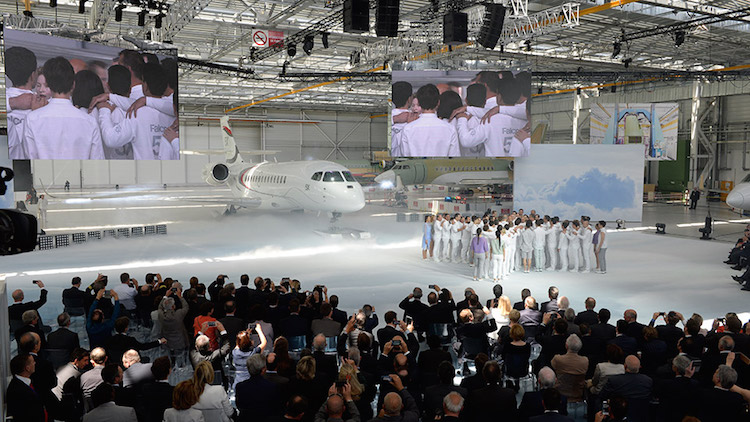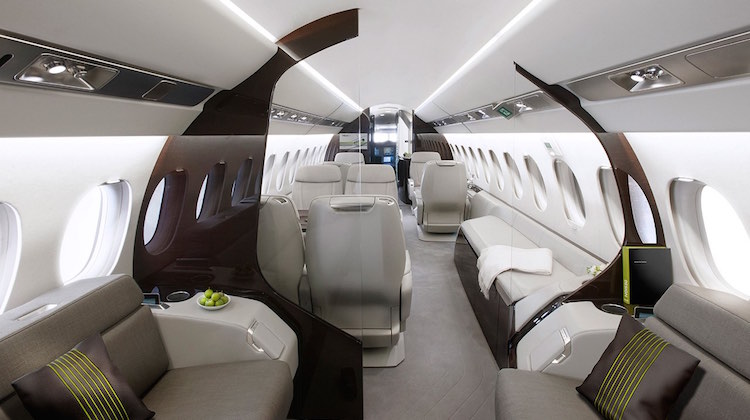 Dassault’s new Falcon 5X jet rolled out June 2 in a flashy ceremony at its Bordeaux-Mérignac facility, and the business jet airframer is expecting its new long-range, large-cabin business jet to be a cornerstone of its six-strong family.
Dassault’s new Falcon 5X jet rolled out June 2 in a flashy ceremony at its Bordeaux-Mérignac facility, and the business jet airframer is expecting its new long-range, large-cabin business jet to be a cornerstone of its six-strong family.
The 5X (formerly codenamed SMS for Super-Mid-Size) offers a larger fuselage diameter and cabin volume than its predecessors, although its size does mean that its range is limited to 5,200nm or 9,630km, lower than its more efficient 7X tri-jet stablemate. The first clean-sheet Falcon jet in a decade is expected to retail for a cool US$45 million.
Looking at the 5X’s sleek lines and attractive proportions, the twinjet is certainly an attractive aircraft, which will provide Dassault some reassurance through the old “if it looks right, it’ll fly right” aphorism.
But the aircraft the 5X reminded me of most — and hear me out here — was the Airbus A380, and particularly the A380-800 version. The superjumbo was built with the expectation of a stretch, and its proportions are that little bit too wide and too short to be obviously the definitively designed version. So it is with the 5X: obviously, this is a more conventionally beautiful plane than the Airbus whalejet, but it’s just as obvious that a stretch is early on the cards.
Quieter, cheaper, more efficient, more flexible, and faster if you want it
Eight passengers and three crewmembers are expected to typically be carried on board the jet, which is 25.2m long and 7.5m high, with a wingspan of 25.9m and a fuselage diameter of 2.7m, although the airframer is also advertising a 14-seater version. It competes in the same class as the Bombardier Global 5000, the shorter range Gulfstream 450, and the future Cessna Citation Longitude.
It’s powered by Snecma’s new Silvercrest SC-1D medium-bypass engine, among the most efficient in its class — and quiet, scoring over ten decibels quieter than the most rigorous stage 4 noise regulations. Its 11,450lb of thrust and advertised increase in fuel efficiency of up to 15 per cent, together with the advanced aerodynamics and Dassault’s new wing, suggest the 5X will be nearly a third more efficient in terms of overall operating costs than the competition.
Adding to its efficiency, composites are used in the wing roots, wingtips, vertical and horizontal stabilisers, and in the nose.
Dassault quotes a 30 per cent reduction on the G450’s costs and 35 per cent over the Global 5000. The environment benefits too, with emissions less than half the most stringent set of standards currently in place. It’s the first time that a Falcon has been launched with a new engine, or indeed with one built by the French enginemaker.
A maximum operating speed of Mach .90 and a long-range cruise speed of Mach .80 compare favourably with its 7X stablemate and with competing jets. While the 5,200nm range numbers are set at Mach .80, that gives a jet based in Sydney the legs to reach all of Japan, most economic destinations in China and a significant proportion of eastern India.
The 5X’s maximum landing weight to maximum takeoff weight ratio is nearly 95 per cent, which enables a greater range of stop, pickup and go missions for the jet.
Bigger cabin, bigger flight deck, bigger windows…
The 5X cabin is at 2.18m wide, 20cm wider than previous Falcon jets, and 1.98m high, comparing very favourably with the Gulfstream 450 and the Bombardier Global 5000. While the overall length of the 5X is 13cm shorter than the 7X, its greater diameter means that it has 14 per cent more volume than its trijet cousin.
In terms of passenger experience, the 5X offers a “zenith window” overhead in the entryway, which allows true natural daylight to flood into the cabin. Where even major commercial airframers like Boeing and Airbus can only offer round cabin monuments in this space, Dassault has gone one further and opened up the ceiling. To manage light and insolation, Vision Systems’ Nuance Dual electronically dimmable window (EDW) — the darkest EDW on the market — uses SPD-Smart light-control film. In addition to the heat reduction bonuses, 99.9975 per cent of visible light is blocked, as is 100 per cent of ultraviolet light. The 28 cabin windows are each an inch larger than the 7X, adding to the amount of light that can be let into the cabin.
A new digital flight control system (DFCS) controls a new wing
The 5X is the second fly-by-wire Falcon jet, building on the technology débuted in the 7X. Expansive flat-panel displays and a pair of sidesticks make the remarkably roomy flightdeck feel high-tech and airliner-like. The wide, open flightdeck windows are 32 per cent larger compared with the 7X, and the extra cockpit space allows Zodiac Aerospace’s pilot seats to recline comfortably through 130 degrees.
The 5X wing features three leading edge slats, a relatively conventional flap, two airbrakes, an aileron and a flaperon. Flaperons, not previously seen on a Falcon model, are a multifunction surface used by the new digital flight control system (DFCS) in a number of different ways: as an additional flap to increase lift or drag, as an aileron to control roll, or a lift-coefficient boosting differential surface alongside the aileron.
The flaperon is inherited from Dassault’s Rafale fighter, and the close-knit French company took pains to mention the link between the technology developed as part of its military development and as part of its business jet business — going as far as to walk the world’s assembled media through a hangar filled with Rafales on the way in to the 5X event at its Bordeaux Mérignac base.
Given the Rafale inheritance, the control systems nor the airframe are introducing any revolutionary or unproven technologies, however — a relief to early-market customers who often end up working through glitches and specification issues.
Once 5X production is well under way, derivatives are also planned, with Dassault mooting an extended version that would particularly usefully serve the Chinese and east Asian market — and it’s all the rumour in Mérignac this year.
In the meantime, Dassault is working towards the 5X’s first flight “before the end of the [northern] summer”.













